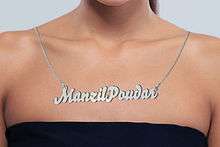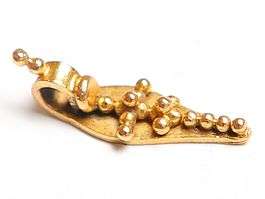Pendant





The word pendant derives from the Latin word "pendere", and Old French word "pendre", both of which translate to "to hang down". It comes in the form of a loose-hanging piece of jewellery, generally attached by a small loop to a necklace, which may be known as a "pendant necklace".[1] A pendant earring is an earring with a piece hanging down. In modern French "pendant" is the gerund form of “hanging” (also meaning “during”).Due to the extent to which the design of a pendant can be incorporated into an overall necklace it is not always accurate to treat them as separate items.[2] In some case though the separation between necklace and pendant is far clearer.[2]
One of the earliest types of bodily adornment is a pendant, (a hanging ornament, as an earring or the main piece suspended from a necklace.) Attractive rocks Shells and other indigenous materials were used. In Ancient Egypt, Pharaohs normally wore scarab beetle pendants to symbolize their wealth and power. Royalty and nobility in Ancient Egypt also wore a certain type of pendant called a cartouche.[1]
Pendants can have several functions, which may be combined:
- Award (i.e., Scouting Ireland Chief Scout's Award, Order of CúChulainn)
- Identification (i.e., religious symbols, sexual symbols, symbols of rock bands)
- Ornamentation
- Ostentation (i.e., jewels).
- Protection (i.e., amulets, religious symbols)
- Self-affirmation (i.e., initials, names)
The many specialized types of pendants include lockets which open, often to reveal an image, and pendilia, which hang from larger objects of metalwork.
Types
Throughout the ages, pendants have come in a variety of forms to serve a variety of purposes.
Amulet
Though amulets come in many forms, a wearable amulet worn around the neck or on the arm or leg in the form of a pendant is the most common. These are objects believed to possess magical or spiritual power to protect the wearer from danger or dispel evil influences.[3]
Talisman
Similar to an amulet, a talisman is an object believed to possess supernatural traits. However, while an amulet is strictly a defensive object, a talisman is meant to confer special benefits or powers upon the wearer.[4]
Locket
A locket is a small object that opens to reveal a space which serves to hold a small object, usually a photograph or a curl of hair. They typically come in the form of a pendant hanging from a necklace, though they will occasionally be hung from a charm bracelet.[5]
Medallion
A medallion is most often a coin-shaped piece of metal worn as a pendant around the neck or pinned onto clothing. These are generally granted as awards, recognitions, or religious blessings.[6]
USB drive
In the first decade of the 21st century, jewellers started to incorporate USB flash drives into pendants.[7][8]
References
| Wikimedia Commons has media related to Pendants. |
- 1 2 "The Early Pendant: A Jewelry And A Talisman". Talismanamulet.org. Retrieved 7 August 2012.
- 1 2 Johns, Catherine (1996). The Jewellery of Roman Britain Celtic and classical Traditions. Routledge. p. 104. ISBN 9780415516129.
- ↑ "amulet". The Columbia Encyclopedia (6th ed.). Encyclopedia.com. 2014. Retrieved 27 October 2014.
- ↑ "Talisman". Encyclopedia of Occultism and Parapsychology. Encyclopedia.com. 2001. Retrieved 27 October 2014.
- ↑ Luscomb, Sally. The Collector's Encyclopedia of Buttons. Atglen, PA: Schiffer. p. 242. ISBN 0-7643-1815-2.
- ↑ "Medal". The Columbia Encyclopedia. Encyclopedia.com. 2014. Retrieved 27 October 2014.
- ↑ Yamamoto, Mike (1 February 2007). "USB as fashion statement". CNet. Retrieved 3 October 2013.
- ↑ Yamamoto, Mike (11 June 2007). "The hot trend in designer jewelry: USB keys". CNet. Retrieved 3 October 2013.